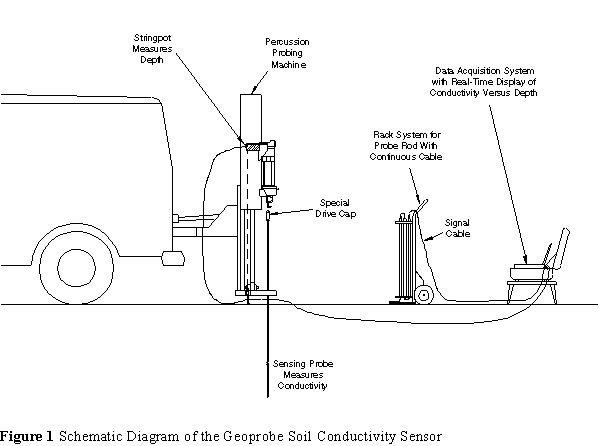
The Geoprobe soil conductivity sensor, shown in the figure below, identifies lithology and potential contamination by measuring the electrical conductivity of soil and hydrogeologic fluids. Soils vary in their electrical conductivity depending on particle size; for example, clays and silts generally have high conductivities, while sand and gravels exhibit low conductivities. Overall, soil and rock are resistant to current. Pore fluids and the amount of dissolved solids in these fluids also influence soil conductivity.

The Geoprobe conductivity sensor uses an isolated array of sensing rings to measure this conductivity. The sensor is principally designed to help determine subsurface stratigraphy. The sensor may also help characterize subsurface contamination, especially where high conductivity leachates or brines are involved.
The principal components of the complete Geoprobe system are as follows:
The hydraulic probing machine uses a combination of pushing and hammering to advance 3-foot-long segments of 2.54-centimeter-diameter hollow steel sampling rods. The conductivity sensor is attached to the lead section of the sampling rod.
The conductivity sensor consists of four stainless-steel contact rings fitted around a central steel shaft. Plastic electronically isolates the contact rings from the steel shaft. A hollow steel rod extends above the uppermost stainless steel ring, housing a shielded signal cable that connects the contact rings with an external power source, measurement system, and data logging system.
The soil conductivity sensor can be used in a dipole array or a Schlumberger array. The dipole array is used when greater resolution is required. The Schlumberger array is generally used when optimal soil-to-probe contact cannot be maintained.
The Geoprobe conductivity sensor is designed to determine subsurface stratigraphy. Only highly conductive contaminants such as oil field brine can be directly measured by the sensor.
The Geoprobe conductivity sensor field demonstration was conducted in September 1994. The final report will be available in 1997.
EPA PROJECT MANAGER:
Steve Billets
U.S. EPA
National Exposure Research Laboratory
Characterization Research Division
P.O. Box 93478
Las Vegas, NV 89193-3478
702-798-2232
Fax: 702-798-3146
TECHNOLOGY DEVELOPER CONTACTS:
Colin Christy
Troy Schmidt
Geoprobe Systems
601 North Broadway Boulevard
Salina, KS 67401
913-825-1842
Fax: 913-825-2097